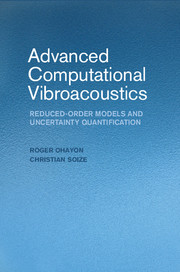Book contents
- Frontmatter
- Contents
- 1 Principal Objectives and a Strategy for Modeling Vibroacoustic Systems
- 2 Definition of the Vibroacoustic System
- 3 External Inviscid Acoustic Fluid Equations
- 4 Internal Dissipative Acoustic Fluid Equations
- 5 Structure Equations
- 6 Vibroacoustic Boundary Value Problem
- 7 Computational Vibroacoustic Model
- 8 Reduced-Order Computational Model
- 9 Uncertainty Quantification in Computational Vibroacoustics
- 10 Symmetric BEM without Spurious Frequencies for the External Acoustic Fluid
- References
- Glossary
- Author Index
- Subject Index
9 - Uncertainty Quantification in Computational Vibroacoustics
Published online by Cambridge University Press: 05 August 2014
- Frontmatter
- Contents
- 1 Principal Objectives and a Strategy for Modeling Vibroacoustic Systems
- 2 Definition of the Vibroacoustic System
- 3 External Inviscid Acoustic Fluid Equations
- 4 Internal Dissipative Acoustic Fluid Equations
- 5 Structure Equations
- 6 Vibroacoustic Boundary Value Problem
- 7 Computational Vibroacoustic Model
- 8 Reduced-Order Computational Model
- 9 Uncertainty Quantification in Computational Vibroacoustics
- 10 Symmetric BEM without Spurious Frequencies for the External Acoustic Fluid
- References
- Glossary
- Author Index
- Subject Index
Summary
UNCERTAINTY AND VARIABILITY
The designed vibroacoustic system is used to manufacture the real vibroacoustic system and to construct the nominal computational vibroacoustic model (also called the mean computational vibroacoustic model or sometime the mean model) using a mathematical-mechanical modeling process for which the main objective is the prediction of the responses of the real vibroacoustic system. This system can exhibit a variability in its responses due to fluctuations in the manufacturing process and due to small variations of the configuration around a nominal configuration associated with the designed vibroacoustic system. The mean computational model that results from a mathematical-mechanical modeling process of the designed vibroacoustic system has parameters (such as geometry, mechanical properties, and boundary conditions) that can be uncertain (for example, parameters related to the structure, the internal acoustic fluid, the wall acoustic impedance). In this case, there are uncertainties on the computational vibroacoustic model parameters, also called uncertainties on the system parameters. On the other hand, the modeling process induces some modeling errors defined as the model uncertainties. Figure 9.1 summarizes the two types of uncertainties in a computational model and the variabilities of a real system.
- Type
- Chapter
- Information
- Advanced Computational VibroacousticsReduced-Order Models and Uncertainty Quantification, pp. 67 - 83Publisher: Cambridge University PressPrint publication year: 2014



